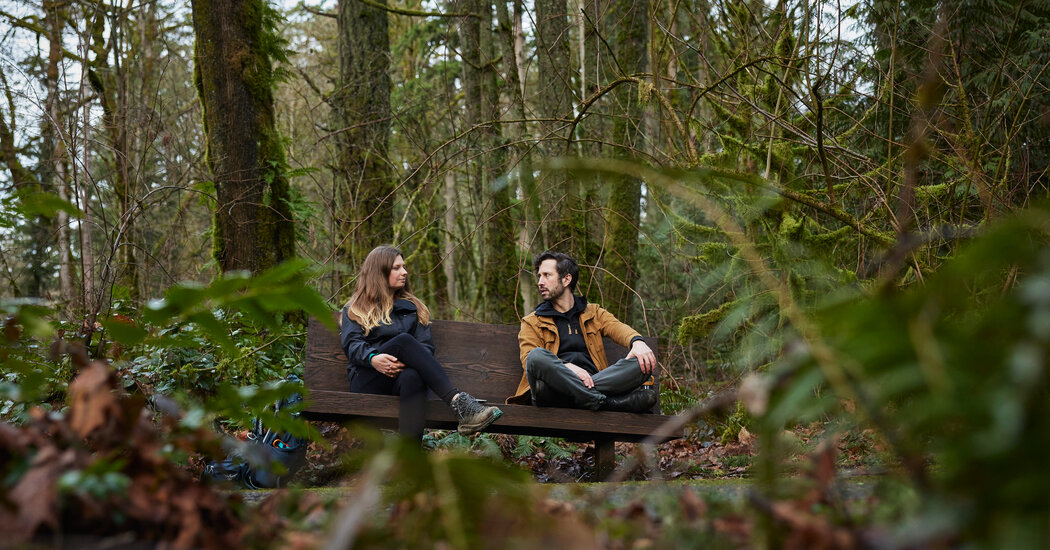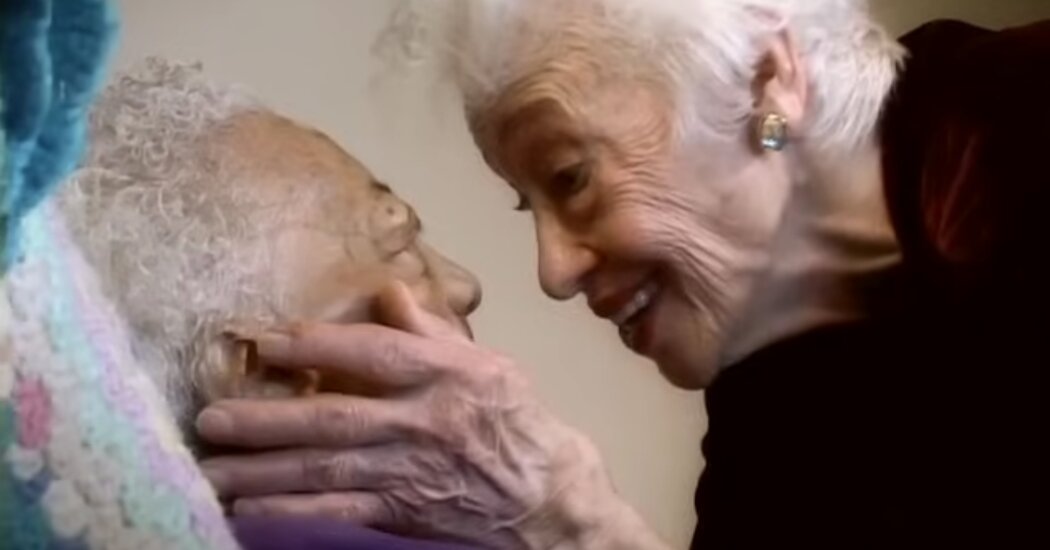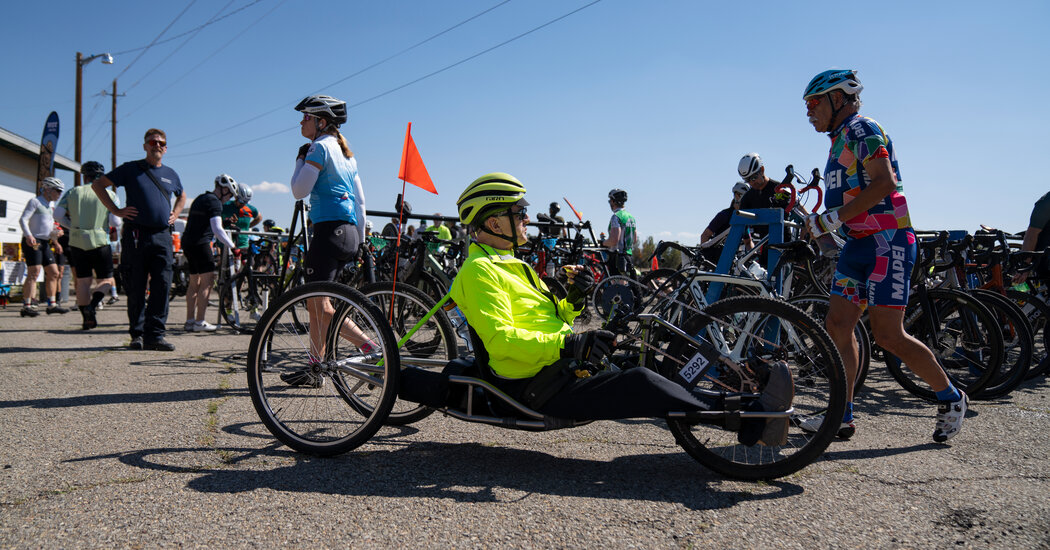Sometimes a pine cone is just a pine cone.
But on a January day, the rough edges of the cone — and the lone feather sticking out of it — meant something different to Rachel Oppenheimer, 25, a counselor at the Chesapeake Mental Health Collaborative in Towson, Md.
“Growing up, I had some challenges,” Ms. Oppenheimer said, referring to her prickly teenage past, “some struggles with managing my emotions.”
But her grandmother, who died four years ago, was soft like the feather, and gave her unconditional love that reminded Ms. Oppenheimer how important it was to treat herself with “soothing tenderness,” especially when she became self-critical.
Ms. Oppenheimer and her clinical supervisor, Heidi Schreiber-Pan, were visiting Talmar, a nonprofit farm that offers therapeutic programs and vocational training — a short drive from the busy road and nondescript strip malls near their office. At the farm, the only sounds were a burbling stream, trilling birds and several inches of snow crunching beneath their feet. It was the perfect location to teach Ms. Oppenheimer therapeutic techniques that make use of the natural world.
They set up camping chairs under a bright blue sky during their session — a makeshift office without walls — and discussed how to create a circular design called a mandala. Next they would arrange items that Ms. Oppenheimer found on the ground, each symbolizing the complex feelings that stemmed from mourning her grandmother.
Dr. Schreiber-Pan is one of a growing number of therapists who are taking their therapy sessions outdoors and, in some cases, training other counselors to do the same. They say that combining traditional talk therapy with nature and movement can help clients feel more open, find new perspectives and express their feelings, all while helping them connect with the outside world.
“It’s a sense of belonging to something bigger — and that is, I think, a really powerful ‘aha!’ moment for a lot of people,” Dr. Schreiber-Pan said. As humans evolved they spent much of their time outdoors, she added, yet our modern life is mostly spent indoors, looking at digital devices.
Outdoor therapy falls under the umbrella of ecotherapy, a broad and nebulous term that includes activities as varied as equine therapy and outings like wilderness and adventure therapy. During the pandemic, while many therapists moved online, others held sessions outside, seeking a safer way to meet in person. But the concept has been around for much longer.
Decades ago, the psychiatrist Dr. Thaddeus Kostrubala, author of the 1976 book “The Joy of Running,” was known for jogging alongside his patients. The practice never really caught on, in part because most therapists were trained to meet with clients in controlled indoor settings, to maintain confidentiality and strong boundaries.
Now, however, students are being trained in ecotherapy at a smattering of schools, including Lewis and Clark College in Oregon and Prescott College in Arizona.
And some therapists, like Dr. Schreiber-Pan, are creating their own curriculums. In 2020, she founded the Center for Nature Informed Therapy, which offers certification and continuing education credits to any social worker or certified counselor who completes the program. So far, more than 100 people have graduated.
Outdoor sessions are not one size fits all. Not every client will want to walk in the snow, for example. Dr. Schreiber-Pan and other therapists also give clients the option to explore nature indoors, drawing from a collection of shells, stones, sticks and spiky gumballs. And there is no special license for this therapy — no established best practices that would dictate the exercises or activities that therapists should use when meeting with clients outdoors.
Some in the field are leery of the emerging discipline. Dr. Petros Levounis, the president of the American Psychiatric Association, said he would feel a bit “skeptical” about taking a patient to the park.
“There is a formality in psychotherapy — tried and true parameters,” he said. “You sit across from them; there’s the 45-minute session. And I don’t know exactly what would happen in the outdoors. It starts raining. What do you do with the patient?”
Psychiatrists need to think about it more carefully, he added, and consider special training “before we sign on the dotted line of such novel interventions.”
Even so, he added, a number of studies have found that being immersed in nature can be beneficial to mental health. A 2023 analysis of the effects of “forest bathing,” the Japanese practice of taking a relaxing walk through the woods, suggested that it can significantly reduce symptoms of depression and anxiety. And being physically active is associated with a lower risk of depression. One review of a variety of studies went so far as to conclude that “physical activity should be a mainstay approach” when managing psychological distress.
‘It connects me to being human’
Outdoor or nature-informed therapy has especially become a big draw for men and people under 40, Dr. Schreiber-Pan and other therapists said.
Chase Brockett, 36, who lives in Portland, Ore., began hiking therapy in 2022 and continued for about a year and a half, despite having to pay for sessions out of pocket.
“It connects me to being human, to being alive,” he said. “Not being subject to the world, but being a part of it.”
During his sessions, he and his therapist, Aimee Frazier, would go out in all kinds of weather, including rain.
“You have to be uncomfortable and just accept that’s what’s happening,” he said, a lesson that became an analogy for his anxiety. “I think a lot of anxiety comes from A) viewing anxiety as a bad thing and B) trying to escape it at all times,” he said.
Therapists also see other benefits: clients who are more receptive and relaxed.
“I think that for some young people, therapy feels very prescribed,” said Andrew Tepper, the founder of Boda Therapy, who often works with adolescents and young adults in New York City and the Catskills. “It’s one lane. Oh, we’re going to sit. We’re going to talk and maybe we’ll play a board game. And with that, I think, comes some resistance.”
Mr. Tepper, a psychotherapist, steers his clients toward outdoor movement — hiking or skiing — if they are receptive to it. During one retreat in early February, he took three clients snowshoeing, went on long walks and cooked lunch over a campfire.
“I believe therapy can be fun, and part of that is doing a little upfront assessment of what your clients like to do,” he said.
‘I began to feel a lot like my wilting office plant’
Therapists are noticing that a nature-informed practice can improve their own well-being and help to stave off professional burnout, too.
Years ago, when Ms. Frazier had finished a clinical internship in a dimly lit, windowless office, she realized that she needed a “more enlivening setting” — for her clients and for herself.
“I began to feel a lot like my wilting office plant that sat in the dark corner,” she said. “I longed to be out in the sun and the rain, surrounded by the calming presence of nature.”
In 2021, she began offering hiking therapy to clients under the supervision of Thomas J. Doherty, a Portland psychologist who founded the certificate program in ecotherapy at Lewis and Clark College. For some clients, she said, the setting makes therapy feel more approachable and less intimidating.
Maria Nazarian, a clinical psychologist in Santa Monica, Calif., does not rent an office. She sees clients only virtually or while walking on the beach, which she described as her “happy place.” And, she said, her clients have benefited from getting off the couch.
Walking side by side promotes collaboration, Dr. Nazarian said, and being on the shore often brings moments of wonder and awe, all of which help build “connectedness and trust.”
‘Winter has to happen’
Amy Fuggi, 63, has been seeing Dr. Schreiber-Pan on and off for six years to cope with grief over her mother’s death.
“You want to push it away — you want to bury it, you want to ignore it,” she said. “But that doesn’t work too well.”
While outside, she said, she feels a “huge connection” to her mother, who loved the outdoors and often planned camping trips for Ms. Fuggi and her siblings.
“I feel like she’s walking with me,” Ms. Fuggi said.
On a sunny Monday recently, she and Dr. Schreiber-Pan waded through the snow to visit a nearby college campus, disappearing into a tree-lined path near a small pond, where they played with the concept of wintering — the ability to lean into the dark times in our lives.
“They have a purpose, you know, just like winter has to happen for us to enjoy spring,” Dr. Schreiber-Pan said.
After the session, Ms. Fuggi said she felt lighter.
“When you’re walking around, you’ve got the fresh air and you’ve got all this openness,” she said. “It’s very easy to just relax and talk about things.”
Rosem Morton contributed reporting for this story.







